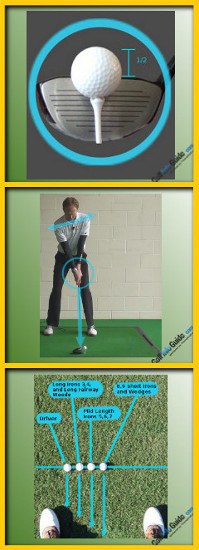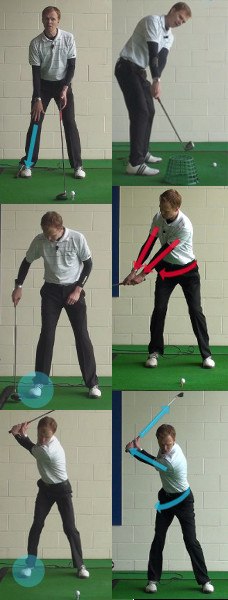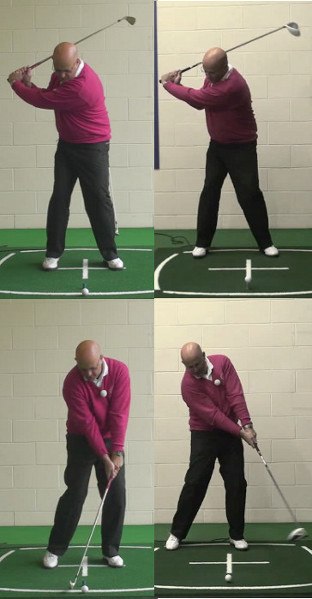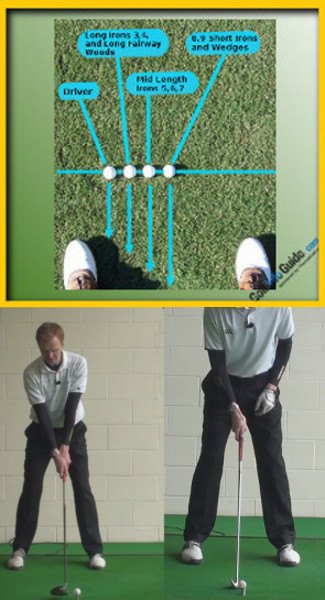
Two golf maxims combine to cause a great deal of confusion. The first: "Hit the driver on the upswing." The second: "Hit down on iron shots."
Sounds like you need two completely different swings, doesn't it? Good news – you don't.
The driver and iron swings are essentially the same. The main difference is ball position and the placement of the ball on a tee (driver), which alters the position of your hands and the angle of your shoulders at address. Here's a brief tutorial:
Hitting the Driver
- Teeing height—About half the ball should be above the top line of the clubface
- Ball position—Opposite the left heel
- Hand placement—Should be level with or slightly behind the ball
- Shaft—Perpendicular to the ground at address, not leaning toward the target
- Shoulders—Right a few inches below left (for right-handed golfers), with the spine tilted a little to the right
Hitting an Iron (from fairway or rough)
- Ball position—Center of the stance for the wedges; a half-inch to the left for each longer iron
- Hand placement—Should be slightly ahead of the ball
- Shaft—Leaning toward the target
- Shoulders—Approximately level, with the right perhaps a touch lower than the left (because the right hand is lower on the club)
If you've set up properly, the driver and iron swings should be basically the same. The fundamentals of the takeaway, backswing, weight shift, hip and shoulder turn, spine angle and head movement apply to both swings.

Do You Need Different Swings for Driver and Irons?
Golf is a challenging game for many reasons, but perhaps none is more important than the fact that you have to hit a variety of different shots in order to get around the course. You can't just make the same swing over and over again with the same club – well you could, but the results wouldn't be very good. If you are going to be a player who can navigate a golf course while making plenty of pars and even a few birdies, you have to have a number of shots at your disposal.
One of the places in your game where you need to be able to adjust on the fly is when moving from your driver swing to your iron swings. Of course, this is a transition that you will make many times throughout the course of a round – you will hit your driver from the tee, only to follow up that swing with an iron for your next shot. So, do you use the same swing for those two different types of club, or is the same swing? Well, the answer is a bit more complicated than you might think. The two swings do have plenty in common to be sure, but there are also some important differences. It is important to the quality of your game that you are able to understand the differences in the two swings well enough to make the proper adjustments to your technique. You don't want to totally reinvent your swing from shot to shot, but you do need to alter your technique slightly when moving from the driver to an iron and vice versa.
While you might need to make a slightly different swing between your driver and your irons, you should remember that the goal of every shot you hit on the course is the same – to hit your target. All shots should have specific targets, and your swing should be made with the goal of hitting that target as precisely as possible. Most golfers do a relatively good job of picking a target for their iron shots, however those same players fail at picking a target for the driver. Since they are often just trying to hit the ball 'as far as possible', plenty of golfers ignore the need for a target from the tee. Don't let yourself fall into that category. Before hitting any shot on the course, no matter what kind of shot it might be, make sure to select a very specific and realistic target.
It should be obvious that developing a different swing for your driver and irons is going to take some practice. The best practice sessions are ones that accurately imitate the situations you are going to deal with on the course. In this case, that means you should be changing back and forth between your driver and irons regularly on the driving range. Instead of hitting ten straight drivers followed by ten straight iron shots, switch back and forth constantly in order to teach yourself how to make that transition successfully.
All of the instruction contained below is based on a right handed golfer. If you happen to play left handed, please take a moment to reverse the directions as necessary.

The Similarities
Fortunately, the driver and iron swings that you are going to make are more alike than they are different. You aren't going to need to change your swing significantly between these two types of clubs, and in fact, you wouldn't want to as your results would be disappointing. The goal should be to keep these two swings largely similar while only applying minor changes between them in order to optimize your ball flight with each club in the bag.
Following is a list of the important similarities that exist between your driver and iron swings.
- Balance. This is the 'golden rule' in golf, and it obviously applies to every single swing that you make around the course. No matter what club happens to be in your hands, balance should always be a top priority. When you are balanced, it becomes easier to make solid contact and your power will increase as well. Poorly balanced swings are never consistent, as it is nearly impossible to catch the ball cleanly time after time while falling off balance. Be careful to avoid making the common mistake of sacrificing balance in an effort to swing harder – that is a trade that you will never win. Balance is always the most important element of your swing, with everything else falling in line behind that point.
- Grip. You also want to use the same grip for all of the full swings that you make during a round, regardless of the club in question. Of course, you may decide to move your hands up or down the grip based on the type of shot you are hitting, but the basic style of your grip does not change. The feel that you have between your hands and the club head is dependent on that grip, so make sure it remains consistent from shot to shot. Moving your grip around unnecessarily would make it significantly harder to square up the club face at impact, which is obviously a road that you don't want to go down.
- Tempo. The overall tempo of your golf swing is another thing that needs to be consistent from swing to swing. If you are going to time up your swings properly, you want to have a nice rhythm that you carry throughout the round, and that should not be changing in any significant way based on the club you are using. Of course, a short iron is going to use a shorter overall swing than would a driver, but the basic tempo of the swing will stay the same. Most amateur golfers tend to ignore the importance of tempo in the swing, which is a big mistake. To give yourself an advantage over the others at your local course, work hard on mastering your own personal tempo and stick with it at all times.
- Release. This is one point where there is some confusion for the amateur golfer. Most players understand that they need to hit up on the driver and hit down on the irons, meaning the clubs are moving different directions through the ball. However, that doesn't mean that your release should change at all. The task of moving the club up or down through impact is going to be done by other fundamentals (that we will cover below). In terms of the release, that action is going to be the same no matter what club you are holding (unless you are trying to hit a 'specialty' shot, like a knockdown). Your hands are moving way too fast through the hitting area to actually 'customize' your release based on which club you are hitting, so don't even try to make changes in that area of the swing. The goal on a full swing should be a full release where your hands allow the club head to tear through the ball while holding nothing back – and that story is the same when hitting a driver or an iron shot.
As you can see, the driver and iron swings have a lot in common. All of the points above should be considered basic golf swing fundamentals that apply across the board in your game, whether you are holding a driver or one of your irons. During any practice session, be sure to focus on the four points included above so that you can keep the basics of your golf swing under control. With these essential elements in place and handled correctly, you can go on to learn about how your swing may need to be adjusted as you move throughout a round between hitting driver and iron shots.

The Differences
At this point, we will get down to the heart of the matter – the difference between hitting a driver and hitting your irons. As has been mentioned above, these differences are generally subtle, but they are important. If you attempt to hit each type of club with the same basic swing and approach, you will inevitably be disappointed in the results. Most likely, you will hit quality shots with either your driver or your irons, while the other will suffer. Or, if you are caught in between, you may find that your swing doesn't fit either of these club types.
To form a clear line between these two different types of swings, you will want to have a clear understanding of the points below. Use these tips to differentiate between your driver and iron swings and your game should improve as a result.
- Stance. The stance that you take over the ball need to vary based on the club you are holding. When hitting a driver, you want your feet to be wider than your shoulders in order to create a stable base for the long and aggressive swing to come. On the other hand, you can keep your feet directly under your shoulders when hitting iron shots. As the irons get shorter, you can continue to narrow your stance, as long as you are able to maintain balance. Varying the width of your stance will help from the perspective of adjusting the plane of your swing. A wider stance generally leads to a flatter swing, which is great for the driver. As you might guess, a narrower stance is better for a steeper swing, which is exactly what you need when playing an iron shot. Spend some time on the driving range experimenting with various stances until you find a comfortable position for each club.
- Ball position. Generally speaking, the ball should almost always be farther forward in your stance when hitting a driver than it is when hitting iron shots. Of course, you aren't going to play all of your iron shots from the same position, but even a long iron will be placed behind the ideal position for the driver. The reason behind this adjustment is simple – you want to be able to hit up on your driver, which requires a ball position that is forward in the stance. For your irons, however, you want to hit down, which is going to demand that you move the ball back slightly. For most players, the driver should be played off of the left heel while the short irons should be played from the middle of the stance. Those two points will serve as your 'extremes', with every other club in the bag falling somewhere in between.
- Shape. You want to make a rounded, flatter swing with the driver as compared to the irons. This point is already made briefly above, but it should be highlighted here for clarity. As you swing the driver back away from the ball, you want to avoid the lifting action that you might use to get your irons up in the air. Again, this all comes back to the idea of being able to hit up on your driver. A flatter plane will leave the club down close to your right shoulder at the top of the swing, which will make it easy to hit up through impact. For iron shots, go ahead and use a little bit of a lifting action in the backswing once the takeaway has been completed. Use your wrists to load the club up into the air and you will be in a nice high position at the top from which you can strike down.
The differences between your driver swing and iron swing are subtle, but they are important. Specifically, you need to make sure you are tailoring both your stance and your ball position to the club that you are holding. The nice thing about making these adjustments is that they are pre-swing adjustments, meaning you don't have to think about them while the club is actually in motion. Take care of these points before you even start the swing, and then forget about them altogether. As long as your setup is appropriate for the club you are using, the swing you wind up making should match nicely.

A Practice Routine
It is important to practice in a way that will help you perform your best on the course. This is another point that was made quickly earlier, but needs to be highlighted again because it is crucially important to your success. The way most amateur golfers spend their practice time is wrong, and they limit their own improvement as a result. If you can change some of your practice habits to more accurately reflect what you will face on the course, your game will certainly take a step forward.
The first thing you need to avoid at the range is hitting the same club over and over again without any change of pace. Hitting your driver 15 or 20 times in a row might be fun, but it isn't going to do you much good on the course. When was the last time you hit that many drivers in a row during a round of golf? Never, of course. You are constantly changing clubs on the course, and you should be doing the same on the range.
It is okay to hit a few shots in a row with the same club early in your session just to get some rhythm, but you should quickly switch over to alternating clubs after every swing. One great way to do this is to simply picture your favorite course and pretend that you are going around it one shot at a time. Take out the club that you would use off of the tee on the first hole – likely a driver – and make a great swing. From there, estimate what club you would need to hit for your next shot and repeat the process. Go through all 18 holes using this method, and you will give your entire bag a great workout.
Another method of practice that can be effective for learning your driver and iron swings is to switch back and forth between a driver and one specific iron for an entire bucket of range balls. The seven iron is a great candidate for this drill because it is long enough to test your swing, but short enough to be relatively easy to hit. Pick out two targets for the drill – one for your driver and one for your seven iron – and start swinging away. Of course, you still want to take your time prior to each swing and give every shot your full attention. Rushing through a practice session never benefitted anyone, so stay under control and focus on your technique and fundamentals at all times.
Practicing properly is one of the keys to actually improving at this difficult game. Many golfers complain that they spend time on the range but never get better – the reality is that these players probably aren't practicing correctly. If you have a good plan and you then execute that plan on the range, your game is sure to improve.

Don't Think Too Much
The goal of all of your practice time should be simple – to allow you to 'turn off' your brain on the course. When you get out onto the golf course for a round, you don't want to be thinking about your swing at all. Your preparation should allow you to swing on auto-pilot while you simply pick targets and make confident swings. If you are constantly thinking about your mechanics while you are playing a round, your performance is always going to fall short of its potential.
As you go back and forth between your driver and your irons on the course, you shouldn't need to think about the technical adjustments that are necessary to hit good shots. Since you have already worked out those details on the driving range, they should now be second nature to you. If not, head back to the range and keep working on your swings using the 'back and forth' methods highlighted above. Not only will you perform better if you don't have to think about the technical side of the game on the course, you will have more fun as well. Golf is far more enjoyable when you can simply pick out a target and let it fly without any thought of your mechanics.
One of the best ways to 'get out of your own head' on the course is to use a proper pre-shot routine. A good routine will help you get into the flow of the round without allowing too many technical points to enter your thinking. Build this routine on the range and then execute it prior to every shot. Some golfers like to stand behind the ball and take a deep breath before taking their stance, while others like to perform a couple of quick 'waggles' over the ball before hitting the shot. Whatever it is that makes you comfortable, make sure you do it each and every time – and don't let it take so long that you are holding up the group behind you.
So if you aren't supposed to think about the technical part of your swing while golfing, what is it that you should be thinking about? Mostly, you want to be thinking about the course. Think of the course as the defense that you are trying to defeat. The course presents a number of challenges in the way of bunkers, water hazards, trees, slopes, and more. Your mind should be focused on creating a strategy that can give you the best possible chance to get around these defenses in order to score.
You don't need to make dramatic swing changes as you go from your driver to your iron and back again, however you will need to tweak a couple of basic points in order to have success. Work out these details on the range and you will be ready to enjoy success when you tee it up on the course.






